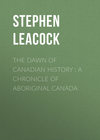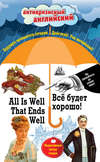Читать книгу: «The Dawn of Canadian History : A Chronicle of Aboriginal Canada», страница 3
The Athapascans stood low in the scale of civilization. Most of them lived in a prairie country where a luxuriant soil, not encumbered with trees, would have responded to the slightest labour. But the Athapascans, in Canada at least, knew nothing of agriculture. With alternations of starvation and rude plenty, they lived upon the unaided bounty of tribes of the far north, degraded by want and indolence, were often addicted to cannibalism.
The Indians beyond the mountains, between the Rockies and the sea, were for the most part quite distinct from those of the plains. Some tribes of the Athapascans, as we have seen, penetrated into British Columbia, but the greater part of the natives in that region were of wholly different races. Of course, we know hardly anything of these Indians during the first two centuries of European settlement in America. Not until the eighteenth century, when Russian traders began to frequent the Pacific coast and the Spanish and English pushed their voyages into the North Pacific,—the Tlingit of the far north, the Salish, Tsimshian, Haida, Kwakiutl-Nootka and Kutenai. It is thought, however, that nearly all the Pacific Indians belong to one kindred stock. There are, it is true, many distinct languages between California and Alaska, but the physical appearance and characteristics of the natives show a similarity throughout.
The total number of the original Indian population of the continent can be a matter of conjecture only. There is every reason, however, to think that it was far less than the absurdly exaggerated figures given by early European writers. Whenever the first explorers found a considerable body of savages they concluded that the people they saw were only a fraction of some large nation. The result was that the Spaniards estimated the inhabitants of Peru at thirty millions. Las Casas, the Spanish historian, said that Hispaniola, the present Hayti, had a population of three millions; a more exact estimate, made about twenty years after the discovery of the island, brought the population down to fourteen thousand! In the same way Montezuma was said to have commanded three million Mexican warriors—an obvious absurdity. The early Jesuits reckoned the numbers of the Iroquois at about a hundred thousand; in reality there seem to have been, in the days of Wolfe and Montcalm, about twelve thousand. At the opening of the twentieth century there were in America north of Mexico about 403,000 Indians, of whom 108,000 were in Canada. Some writers go so far as to say that the numbers of the natives were probably never much greater than they are to-day. But even if we accept the more general opinion that the Indian population has declined, there is no evidence to show that the population was ever more than a thin scattering of wanderers over the face of a vast country. Mooney estimates that at the coming of the white man there were only about 846,000 aborigines in the United States, 220,000 in British America, 72,000 in Alaska, and 10,000 in Greenland, a total native population of 1,148,000 from the Mississippi to the Atlantic.
The limited means of support possessed by the natives, their primitive agriculture, their habitual disinclination to settled life and industry, their constant wars and the epidemic diseases which, even as early as the time of Jacques Cartier, worked havoc among them, must always have prevented the growth of a numerous population. The explorer might wander for days in the depths of the American forest without encountering any trace of human life. The continent was, in truth, one vast silence, broken only by the roar of the waterfall or the cry of the beasts and birds of the forest.
CHAPTER IV
THE LEGEND OF THE NORSEMEN
There are many stories of the coming of white men to the coasts of America and of their settlements in America long before the voyage of Christopher Columbus. Even in the time of the Greeks and Romans there were traditions and legends of sailors who had gone out into the 'Sea of Darkness' beyond the Pillars of Hercules—the ancient name for the Strait of Gibraltar—and far to the west had found inhabited lands. Aristotle thought that there must be land out beyond the Atlantic, and Plato tells us that once upon a time a vast island lay off the coasts of Africa; he calls it Atlantis, and it was, he says, sunk below the sea by an earthquake. The Phoenicians were wonderful sailors; their ships had gone out of the Mediterranean into the other sea, and had reached the British Isles, and in all probability they sailed as far west as the Canaries. We find, indeed, in classical literature many references to supposed islands and countries out beyond the Atlantic. The ancients called these places the Islands of the Blessed and the Fortunate Isles. It is, perhaps, not unnatural that in the earlier writers the existence of these remote and mysterious regions should be linked with the ideas of the Elysian Fields and of the abodes of the dead. But the later writers, such as Pliny, and Strabo, the geographer, talked of them as actual places, and tried to estimate how many Roman miles they must be distant from the coast of Spain.
There were similar legends among the Irish, legends preserved in written form at least five hundred years before Columbus. They recount wonderful voyages out into the Atlantic and the discovery of new land. But all these tales are mixed up with obvious fable, with accounts of places where there was never any illness or infirmity, and people lived for ever, and drank delicious wine and laughed all day, and we cannot certify to an atom of historic truth in them.
Still more interesting, if only for curiosity's sake, are weird stories that have been unearthed among the early records of the Chinese. These are older than the Irish legends, and date back to about the sixth century. According to the Chinese story, a certain Hoei-Sin sailed out into the Pacific until he was four thousand miles east of Japan. There he found a new continent, which the Chinese records called Fusang, because of a certain tree—the fusang tree,—out of the fibres of which the inhabitants made, not only clothes, but paper, and even food. Here was truly a land of wonders. There were strange animals with branching horns on their heads, there were men who could not speak Chinese but barked like dogs, and other men with bodies painted in strange colours. Some people have endeavoured to prove by these legends that the Chinese must have landed in British Columbia, or have seen moose or reindeer, since extinct, in the country far to the north. But the whole account is so mixed up with the miraculous, and with descriptions of things which certainly never existed on the Pacific coast of America, that we can place no reliance whatever upon it.
The only importance that we can attach to such traditions of the discovery of unknown lands and peoples on a new continent is their bearing as a whole, their accumulated effect, on the likelihood of such discovery before the time of Columbus. They at least make us ready to attach due weight to the circumstantial and credible records of the voyages of the Norsemen. These stand upon ground altogether different from that of the dim and confused traditions of the classical writers and of the Irish and Chinese legends. In fact, many scholars are now convinced that the eastern coast of Canada was known and visited by the Norsemen five hundred years before Columbus.
From time immemorial the Norsemen were among the most daring and skilful mariners ever known. They built great wooden boats with tall, sweeping bows and sterns. These ships, though open and without decks, were yet stout and seaworthy. Their remains have been found, at times lying deeply buried under the sand and preserved almost intact. One such vessel, discovered on the shore of Denmark, measured 72 feet in length. Another Viking ship, which was dug up in Norway, and which is preserved in the museum at Christiania, was 78 feet long and 17 feet wide. One of the old Norse sagas, or stories, tells how King Olaf Tryggvesson built a ship, the keel of which, as it lay on the grass, was 74 ells long; in modern measure, it would be a vessel of about 942 tons burden. Even if we make allowance for the exaggeration or ignorance of the writer of the saga, there is still a vast contrast between this vessel and the little ship Centurion in which Anson sailed round the world.
It is needless, however, to prove that the Norsemen could have reached America in their ships. The voyages from Iceland to Greenland which we know they made continually for four hundred years were just as arduous as a further voyage from Greenland to the coast of Canada.
The story of the Norsemen runs thus. Towards the end of the ninth century, or nearly two hundred years before the Norman conquest, there was a great exodus or outswarming of the Norsemen from their original home in Norway. A certain King Harold had succeeded in making himself supreme in Norway, and great numbers of the lesser chiefs or jarls preferred to seek new homes across the seas rather than submit to his rule. So they embarked with their seafaring followers—Vikings, as we still call them—often, indeed, with their wives and families, in great open ships, and sailed away, some to the coast of England, others to France, and others even to the Mediterranean, where they took service under the Byzantine emperors. But still others, loving the cold rough seas of the north, struck westward across the North Sea and beyond the coasts of Scotland till they reached Iceland. This was in the year 874. Here they made a settlement that presently grew to a population of fifty thousand people, having flocks and herds, solid houses of stone, and a fine trade in fish and oil with the countries of Northern Europe. These settlers in Iceland attained to a high standard of civilization. They had many books, and were fond of tales and stories, as are all these northern peoples who spend long winter evenings round the fireside. Some of the sagas, or stories, which they told were true accounts of the voyages and adventures of their forefathers; others were fanciful stories, like our modern romances, created by the imagination; others, again, were a mixture of the two. Thus it is sometimes hard to distinguish fact and fancy in these early tales of the Norsemen. We have, however, means of testing the stories. Among the books written in Iceland there was one called the 'National Name-Book,' in which all the names of the people were written down, with an account of their forefathers and of any notable things which they had done.
It is from this book and from the old sagas that we learn how the Norsemen came to the coast of America. It seems that about 900 a certain man called Gunnbjorn was driven westward in a great storm and thrown on the rocky shore of an ice-bound country, where he spent the winter. Gunnbjorn reached home safely, and never tried again to find this new land; but, long after his death, the story that there was land farther west still lingered among the settlers in Iceland and the Orkneys, and in other homes of the Norsemen. Some time after Gunnbjorn's voyage it happened that a very bold and determined man called Eric the Red, who lived in the Orkneys, was made an outlaw for having killed several men in a quarrel. Eric fled westward over the seas about the year 980, and he came to a new country with great rocky bays and fjords as in Norway. There were no trees, but the slopes of the hillsides were bright with grass, so he called the country Greenland, as it is called to this day. Eric and his men lived in Greenland for three years, and the ruins of their rough stone houses are still to be seen, hard by one of the little Danish settlements of to-day. When Eric and his followers went back to Iceland they told of what they had seen, and soon he led a new expedition to Greenland. The adventurers went in twenty-five ships; more than half were lost on the way, but eleven ships landed safely and founded a colony in Greenland. Other settlers came, and this Greenland colony had at one time a population of about two thousand people. Its inhabitants embraced Christianity when their kinsfolk in other places did so, and the ruins of their stone churches still exist. The settlers raised cattle and sheep, and sent ox hides and seal skins and walrus ivory to Europe in trade for supplies. But as there was no timber in Greenland they could not build ships, and thus their communication with the outside world was more or less precarious. In spite of this, the colony lasted for about four hundred years. It seems to have come to an end at about the beginning of the fifteenth century. The scanty records of its history can be traced no later than the year 1409. What happened to terminate its existence is not known. Some writers, misled by the name 'Greenland,' have thought that there must have been a change of climate by which the country lost its original warmth and verdure and turned into an arctic region. There is no ground for this belief. The name 'Greenland' did not imply a country of trees and luxuriant vegetation, but only referred to the bright carpet of grass still seen in the short Greenland summer in the warmer hollows of the hillsides. It may have been that the settlement, never strong in numbers, was overwhelmed by the Eskimos, who are known to have often attacked the colony: very likely, too, it suffered from the great plague, the Black Death, that swept over all Europe in the fourteenth century. Whatever the cause, the colony came to an end, and centuries elapsed before Greenland was again known to Europe.
This whole story of the Greenland settlement is historical fact which cannot be doubted. Partly by accident and partly by design, the Norsemen had been carried from Norway to the Orkneys and the Hebrides and Iceland, and from there to Greenland. This having happened, it was natural that their ships should go beyond Greenland itself. During the four hundred years in which the Norse ships went from Europe to Greenland, their navigators had neither chart nor compass, and they sailed huge open boats, carrying only a great square sail. It is evident that in stress of weather and in fog they must again and again have been driven past the foot of Greenland, and must have landed somewhere in what is now Labrador. It would be inconceivable that in four centuries of voyages this never happened. In most cases, no doubt, the storm-tossed and battered ships, like the fourteen vessels that Eric lost, were never heard of again. But in other cases survivors must have returned to Greenland or Iceland to tell of what they had seen.
This is exactly what happened to a bold sailor called Bjarne, the son of Herjulf, a few years after the Greenland colony was founded. In 986 he put out from Iceland to join his father, who was in Greenland, the purpose being that, after the good old Norse custom, they might drink their Christmas ale together. Neither Bjarne nor his men had ever sailed the Greenland sea before, but, like bold mariners, they relied upon their seafaring instinct to guide them to its coast. As Bjarne's ship was driven westward, great mists fell upon the face of the waters. There was neither sun nor stars, but day after day only the thick wet fog that clung to the cold surface of the heaving sea. To-day travellers even on a palatial steamship, who spend a few hours shuddering in the chill grey fog of the North Atlantic, chafing at delay, may form some idea of voyages such as that of Bjarne Herjulf and his men. These Vikings went on undaunted towards the west. At last, after many days, they saw land, but when they drew near they saw that it was not a rugged treeless region, such as they knew Greenland to be, but a country covered with forests, a country of low coasts rising inland to small hills, and with no mountains in sight. Accordingly, Bjarne said that this was not Greenland, and he would not stop, but turned the vessel to the north. After two days they sighted land again, still on the left side, and again it was flat and thick with trees. The sea had fallen calm, and Bjarne's men desired to land and see this new country, and take wood and water into the ship. But Bjarne would not. So they held on their course, and presently a wind from the south-west carried them onward for three days and three nights. Then again they saw land, but this time it was high and mountainous, with great shining caps of snow. And again Bjarne said, 'This is not the land I seek.' They did not go ashore, but sailing close to the coast they presently found that the land was an island. When they stood out to sea again, the south wind rose to a gale that swept them towards the north, with sail reefed down and with their ship leaping through the foaming surges. Three days and nights they ran before the gale. On the fourth day land rose before them, and this time it was Greenland. There Bjarne found his father, and there, when not at sea, he settled for the rest of his days.
Such is the story of Bjarne Herjulf, as the Norsemen have it. To the unprejudiced mind there is every reason to believe that his voyage had carried him to America, to the coast of the Maritime Provinces, or of Newfoundland or Labrador. More than this one cannot say. True, it is hard to fit the 'two days' and the 'three days' of Bjarne's narrative into the sailing distances. But every one who has read any primitive literature, or even the Homeric poems, will remember how easily times and distances and numbers that are not exactly known are expressed in loose phrases not to be taken as literal.
The news of Bjarne's voyage and of his discovery of land seems to have been carried presently to the Norsemen in Iceland and in Europe. In fact, Bjarne himself made a voyage to Norway, and, on account of what he had done, figured there as a person of some importance. But people blamed Bjarne because he had not landed on the new coasts, and had taken so little pains to find out more about the region of hills and forests which lay to the south and west of Greenland. Naturally others were tempted to follow the matter further. Among these was Leif, son of Eric the Red. Leif went to Greenland, found Bjarne, bought his ship, and manned it with a crew of thirty-five. Leif's father, Eric, now lived in Greenland, and Leif asked him to take command of the expedition. He thought, the saga says, that, since Eric had found Greenland, he would bring good luck to the new venture. For the time, Eric consented, but when all was ready, and he was riding down to the shore to embark, his horse stumbled and he fell from the saddle and hurt his foot. Eric took this as an omen of evil, and would not go; but Leif and his crew of thirty-five set sail towards the south-west. This was in the year 1000 A.D., or four hundred and ninety-two years before Columbus landed in the West Indies.
Leif and his men sailed on, the saga tells us, till they came to the last land which Bjarne had discovered. Here they cast anchor, lowered a boat, and rowed ashore. They found no grass, but only a great field of snow stretching from the sea to the mountains farther inland; and these mountains, too, glistened with snow. It seemed to the Norsemen a forbidding place, and Leif christened it Helluland, or the country of slate or flat stones. They did not linger, but sailed away at once. The description of the snow-covered hills, the great slabs of stone, and the desolate aspect of the coast conveys at least a very strong probability that the land was Labrador.
Leif and his men sailed away, and soon they discovered another land. The chronicle does not say how many days they were at sea, so that we cannot judge of the distance of this new country from the Land of Stones. But evidently it was entirely different in aspect, and was situated in a warmer climate. The coast was low, there were broad beaches of white sand, and behind the beaches rose thick forests spreading over the country. Again the Norsemen landed. Because of the trees, they gave to this place the name of Markland, or the Country of Forests. Some writers have thought that Markland must have been Newfoundland, but the description also suggests Cape Breton or Nova Scotia. The coast of Newfoundland is, indeed, for the most part, bold, rugged, and inhospitable.
Leif put to sea once more. For two days the wind was from the north-east. Then again they reached land. This new region was the famous country which the Norsemen called Vineland, and of which every schoolboy has read. There has been so much dispute as to whether Vineland—this warm country where grapes grew wild—was Nova Scotia or New England, or some other region, that it is worth while to read the account of the Norse saga, literally translated:
They came to an island, which lay on the north side of the land, where they disembarked to wait for good weather. There was dew upon the grass; and having accidentally got some of the dew upon their hands and put it to their mouths, they thought that they had never tasted anything so sweet. Then they went on board and sailed into a sound that was between the island and a point that went out northwards from the land, and sailed westward past the point. There was very shallow water and ebb tide, so that their ship lay dry; and there was a long way between their ship and the water. They were so desirous to get to the land that they would not wait till their ship floated, but ran to the land, to a place where a river comes out of a lake. As soon as their ship was afloat they took the boats, rowed to the ship, towed her up the river, and from thence into the lake, where they cast anchor, carried their beds out of the ship, and set up their tents.
They resolved to put things in order for wintering there, and they erected a large house. They did not want for salmon, in both the river and the lake; and they thought the salmon larger than any they had ever seen before. The country appeared to them to be of so good a kind that it would not be necessary to gather fodder for the cattle for winter. There was no frost in winter, and the grass was not much withered. Day and night were more equal than in Greenland and Iceland.
The chronicle goes on to tell how Leif and his men spent the winter in this place. They explored the country round their encampment. They found beautiful trees, trees big enough for use in building houses, something vastly important to men from Greenland, where no trees grow. Delighted with this, Leif and his men cut down some trees and loaded their ship with the timber. One day a sailor, whose home had been in a 'south country,' where he had seen wine made from grapes, and who was nicknamed the 'Turk,' found on the coast vines with grapes, growing wild. He brought his companions to the spot, and they gathered grapes sufficient to fill their ship's boat. It was on this account that Leif called the country 'Vineland.' They found patches of supposed corn which grew wild like the grapes and reseeded itself from year to year. It is striking that the Norse chronicle should name these simple things. Had it been a work of fancy, probably we should have heard, as in the Chinese legends, of strange demons and other amazing creatures. But we hear instead of the beautiful forest extending to the shore, the mountains in the background, the tangled vines, and the bright patches of wild grain of some kind ripening in the open glades-the very things which caught the eye of Cartier when, five centuries later, he first ascended the St Lawrence.





















